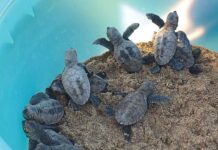Story by Sky Barnhart
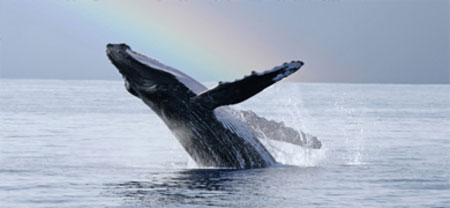
A forty-five-ton whale breaches straight into the air, broad back glistening, before crashing back into the ocean with a tremendous splash. Glancing out of his car window on his way to work, Daniel Bergan enjoys the show. Every year from November to May, the whales are part of his morning drive from Napili to Kahului.
“It’s one of the things I love most about living on Maui,” Bergan says. “Especially in the early morning, driving along the ocean and seeing the whales on my way to work makes the whole day beautiful.”
Bergan is one of thousands of Maui residents and visitors who feel a special connection with the humpback whales that visit here every winter. Like Bergan, the whales are commuters too, but of an incredible distance, traveling as much as 5,000 miles from their feeding grounds in Alaska to breed and give birth in the warm waters of the ‘Au‘au Channel between Maui and Lana‘i.
This year, there promise to be more humpback whales than ever moving through Hawaiian waters: an estimated 8,000. According to Meagan Jones, executive director of Whale Trust, a nonprofit research organization, the population of humpbacks is increasing at an estimated 7 percent per year. That’s good news for an endangered species whose population was 95 percent destroyed by commercial whaling before gaining protection in the North Pacific in 1966.
But it’s not time to take humpback whales off the endangered list just yet. For one thing, population estimates are just that: estimates. Researchers are still struggling to find an accurate way of counting the creatures that roam a vast aquatic world largely inaccessible to human eyes.
“In the old days, they’d go out whaling and watch over time how the number they caught decreased,” says David Mattila of the Hawaiian Islands Humpback Whale National Marine Sanctuary in Kihei.
Today, methods are more sophisticated—and more painstaking, as members of SPLASH can testify. The acronym stands for “Structure of Populations, Levels of Abundance and Status of Humpbacks,” an international cooperative effort to assess their status—whether the number of humpbacks in the North Pacific is increasing, and what impact human activity may have on the health and lifespan of those populations. SPLASH scientists and researchers are now analyzing data collected in the winter/breeding areas from 2004 to 2006 and in the summer/feeding areas from 2004 to 2005.
According to Mattila, who is on the SPLASH steering committee, researchers focus on three main components: matching tail patterns, analyzing tissue samples, and evaluating health and human impact.
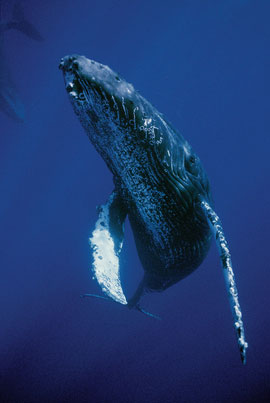
“A tail pattern is like a fingerprint,” Mattila explains. “Once you’ve identified an individual whale, you can get insight into its movements.”
SPLASH researchers photograph the black-and-white undersides of whale flukes and store the images in a central archive. By painstakingly matching photographs taken at different times, they can analyze humpback whale population sizes, migration, sexual maturity and behavior patterns.
Researchers also evaluate tissue samples, taken by shooting a small, stainless steel biopsy dart from a crossbow. Each dart is fitted with flotation material and a flange that causes the dart to recoil after grabbing a small piece of the whale’s skin.
While the sampling procedure may sound painful to us, Mattila says it’s actually “like a mosquito bite” to the whale. Researchers can conduct over forty types of analysis with the tissue sample—including genetic, life history and contaminant analyses.
Based on findings thus far, Mattila says the overall health of the humpback whale in Hawaiian waters seems to be “pretty good.”
“We are looking for uniformity and color of the skin, thinness or emaciation [of the animal], things like that,” he says. “We are seeing some whales that have bumps all over them, and we don’t know if that’s something benign—a natural reaction to remoras sucking on them—or something like a herpes virus.” The strange bumps will be discussed next summer at an international conference on whale skin lesions.
Much about whales is still so unknown that even the dangers facing them are not yet fully understood. But here in Hawai‘i, two threats in particular are becoming increasingly real—entanglements and ship strikes.
Marine debris and stationary fishing gear are extremely dangerous to whales, according to Edward Lyman, marine mammal response manager for the Sanctuary. During the 2006/2007 season, Lyman, Mattila (the Sanctuary’s science and rescue coordinator) and their crew confirmed seven reports of entangled humpbacks in Hawai‘i. The number has increased from past years, but that could be due to more public awareness.
When Lyman’s team gets a report, they make a valiant effort to find and free the whale, working from an inflatable raft and using special equipment, under a permit from the Marine Mammal Health and Stranding Response Program of the National Oceanic and Atmospheric Administration’s (NOAA) Fisheries branch. They also collaborate with the U.S. Coast Guard’s Division of Aquatic Resources and other researchers.
Cutting a whale free of gear is difficult, but hugely rewarding, says Lyman. One whale freed last year was entangled in an Alaskan crab trap weighing over 700 pounds, its heavy lines approximately one inch in diameter. According to Lyman, it’s “a testament to the animal’s strength that [it] can haul even portions of this gear” from Alaska to Hawai‘i. Once cut free, the whale appeared to be in much better condition and have a good chance of survival.
But two other whales sustained serious damage before rescuers could partly disentangle them. Both were emaciated and had large numbers of whale lice (which feed on the dead tissue sloughing off the whale, a sign of poor health). It is doubtful that these whales survived.
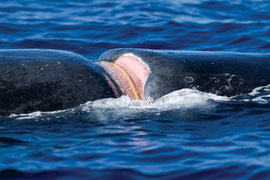
Flip Nicklin: Obtained under NMFS permit#753
“We know we’re not going to cut every whale free,” Lyman says. “But we learn from every entanglement so that we can go back to the source and prevent it in future.”
The 2006/2007 season also saw six reports of ship strikes in Hawai‘i. Colliding with a ship can cause massive blunt trauma to a whale, often resulting in significant injury or death. The increasing number of whales, combined with bigger and faster boats, is a growing concern.
The contested arrival of the Hawai‘i Superferry has spurred fears that the fast-moving vessel may strike and injure or kill whales. According to Lyman, the Sanctuary is addressing the Superferry issue “in a broad sense.” “We’re concerned in regard to all boating traffic out there,” he says.
Jones credits the Superferry issue with triggering greater community awareness of whales, and “an outpouring of concern.” She says Mauians have countless opportunities to help with whales’ protection and growth—“everything from volunteering at one of the local organizations working on behalf of whales, to looking at their own habits and learning about the health of the ocean.”
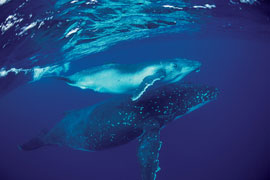
“But we don’t want people getting hurt,” Lyman says. He urges anyone seeing an entangled or injured whale to report it to the NOAA hotline at (888) 256-9840, rather than trying to help on their own.
Outside the realm of known threats are the unknown dangers. One of the most potentially serious of these is climate change.
“A rise in ocean temperature could affect the whales’ food supply, migration routes [from feeding areas to breeding grounds] and reproduction,” Jones says. “The real issue is food supply because that affects every part of their life cycle. If they don’t have food, they’re not going to be able to reproduce, so there are a lot of different implications.”
Then there’s the threat of military sonar in the underwater environment, which has reportedly disturbed beaked whales and pilot whales, causing them to strand. But no one yet knows the effects of mid-frequency sonar on humpback whales.
Alison Stimpert, a graduate student at University of Hawai‘i, is conducting research to discover exactly what a normal underwater soundscape is like for humpback whales in Hawai‘i. “How are these animals using sounds as they compete for access to mates?” Stimpert hopes to find out. “And will human-produced noise [including sonar] introduced into the underwater environment have an effect on these behaviors?”
Stimpert uses tags attached to the whales by suction cups to record data on how the whales are swimming and what sounds are in the area—sounds the whales produce, and sounds in the environment, like passing ships. “To ‘save the whales,’ we also need to save their environment—including their acoustic environment,” she says.
Despite threats both known and unknown, Jones expresses “cautious optimism” that things are looking up for Maui’s humpback whales. “For all of us who have spent our lives working with these animals, to have a glimmer of hope is important,” she says. “We can turn things back that brought a species to the point of extinction.”
Whale Quest Kapalua
Eager to learn more about Maui’s annual visitors? The Ritz-Carlton, Kapalua, becomes a humpback whale lover’s paradise during the third annual Whale Quest Kapalua, February 15 to 17.
The free event, which is hosted by Kapalua Land Company in partnership with Whale Trust, features educational seminars presented by leading researchers, photographers, videographers and journalists; as well as outreach for Maui schools, interactive education and art exhibits, a charity golf tournament, and daily whale watches. More than 4,000 people participated in last year’s event, which raised over $65,000 for whale research in Hawai‘i.
Information: www.whalequestkapalua.com
More of Flip Nicklin’s photography is featured in the forthcoming book Humpback Whales: Behavior on the Hawaiian Breeding Grounds by Dr. Jim Darling. Look for it at Borders, or contact Whale Trust: (808) 873-9600 or info@whaletrust.org.



